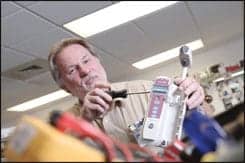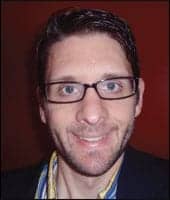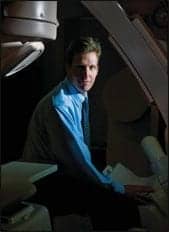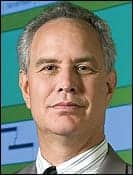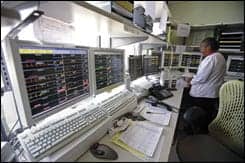 |
| Marion Rogers, monitor technician, reviews a patient’s full disclosure data in the “war room.” |
When the staff at Cooper University Hospital, Camden, NJ, wanted to purchase 200 additional infusion pumps last year, hospital officials were inclined to say yes. The price tag was steep—close to $1 million—but infusion pumps are incredibly useful devices. Able to administer fluids more efficiently and economically than manual techniques, pumps are relied upon by nurses for injections usually deemed too small for drips.
Before taking the financial plunge, administrators asked Bernard A. Benesby, CBET, director of biomedical engineering at the 490-bed teaching hospital, to see if the purchase was truly necessary. Fortunately, Benesby and his team are familiar with such requests. When officials wanted a “war room,” team members designed a central monitoring station for telemetry and bedside monitors. The new sanctuary now serves as a space where all physiological patient data can be accessed, analyzed, and tracked from a single point. The war room usually houses four technicians at a time who watch hundreds of patients throughout the hospital, increasing patient safety and reducing the need for more full-time employees in individual departments.
With the war room experience under his belt, Benesby welcomed the new pump project—and quickly determined that he needed accurate utilization numbers. Since all IV pumps can be tracked when turned “on” using a Cisco wireless network, Benesby revealed (with help from IT) that daily pump usage rarely exceeded 230, and the hospital owned 427 units.
The necessary pumps were around, but they were as elusive as matching socks in the laundry basket. “There were about 200 pumps out there sitting somewhere in somebody’s closet, on somebody’s floor, or in somebody’s room not being used,” Benesby says. “At that point, we decided that we did not need to purchase more pumps. However, we needed to figure out how to get those pumps, and get them quickly when they were needed.”
 |
 |
| Bernard A. Benesby, CBET, director of biomedical engineering. | From front to back: Lucille Davis, Alice Davis, Stephen Zubrzycki, and Hector Rosa, part of Cooper’s pump team, prepare pumps for patient care, which have to be delivered to the nursing floor within 10 minutes of the initial phone request. |
In addition to avoiding the lump-sum purchase, Cooper undeniably saved a lot of money (an estimated $25K per year) on rental equipment. “If there were not enough found, central supply would be likely to order more from the local rental company, and then you are paying daily rental fees,” says John Cabrelli, a biomedical equipment specialist who takes care of operating room equipment. “We avoided all that, and we eventually went around and got rid of all the rentals that we still had.”
When it comes to the ubiquitous infusion pumps, biomeds rarely have the time and motivation for reconnaissance missions. In short, they need help. For Benesby, a 25-year biomed veteran, that help came in the form of four full-time employees dedicated to the specific task of finding, scanning, and bringing back pumps to the biomed department. “It has always been mind boggling for any biomed department, or any nursing department, to find pumps,” Benesby says. “This is one of the biggest issues in every hospital that I have known. It is handled by central supply at many facilities, but there is no rhyme or reason as to how they are doing it.”
The task is made harder by staff who hoard the devices, ever fearful that they will not be around when needed. With this in mind, Benesby’s idea to add four dedicated employees (and their requisite salaries and benefits) first required gaining the trust of the nursing department, while also justifying the expense to hospital financial administrators. The hiring of employees proved to be the easy part. After all, the proposed “pump team” did not have to be composed of highly skilled biomeds, and it would take a while before salaries and benefits tallied $1 million.
Thanks to the biomed department’s sterling reputation within the hospital, nursing directors embraced the pump team concept, even expressing relief that Benesby was willing to take on the project. The relatively easy buy-in came courtesy of the biomedical engineering department’s incredible satisfaction rating: a 4.9 out of 5.0—the top number at Cooper.
People Power
Technology is a wonderful thing, but technology in the hands of capable employees can fundamentally shift paradigms. Such is the case at Cooper, where the marriage of bar code scanning and old-fashioned human persistence has made infusion confusion a thing of the past. With Alaris pumps networked throughout the facility, wireless pharmacy updates are also easily done, providing that crucial safety barrier for patients. Tracking the devices that are turned on is also easy thanks to a system used by IT.
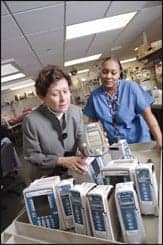 |
| L-R: Bonnie Aichroth, biomedical coordinator, scans pumps for Lucille Davis before delivery |
These conveniences make life easier, but again the crucial ingredients are the pump team and bar code scanning. Bonnie Aichroth, a biomedical engineering coordinator who supervises the pump team, confirms that nurses frequently got tired of searching for equipment, especially pumps, prior to the start of the program. “Now the pump team distributes the pumps, keeps track of the pumps, and helps the biomed guys complete their preventive maintenance on the pumps,” Aichroth says. “The members of the team literally go out and find the pumps, and they use a scanner to scan the bar coded numbers that are found on each device, which we call our control numbers. It is essentially our inventory list, which is in the computer. I can tell where the pump has been, how many times it has come in for cleaning, and when it has been in a certain room or a certain floor.”
Two of the four pump team members were culled from within—one from housekeeping and one from central supply. The remaining two were outside hires. Team members work full shifts 7 days per week, doing nothing but tending to infusion pumps. Aichroth reports that team members have a good rapport with the people on all the floors, including housekeeping. In fact, housekeeping will actually pull the pumps out of the room and call team members after patients are discharged.
These four employees, whose sole focus is infusion pumps, have more than enough work to occupy a full shift. “We have a strict turnaround time, and we promise nurses that they will have a pump within 10 minutes of their phone call, and we deliver on that promise,” Aichroth says. “They are out running around constantly, and rarely get downtime. They even look in the bathrooms, because some staff are still known to hide things. They are on every floor, every day. They check every nook and cranny. However, we don’t have to have them go into drawers or cabinets really anymore, because nurses know they are going to get a pump when they ask for it.”
The scanners used by team members are small, wireless, handheld PDA devices using the MediMizer program, made by Tiscor. Pumps are scanned every time they are moved, used, cleaned, or stored. Information that is scanned gets downloaded into Cooper’s main MediMizer computer system, where reports are generated.
MediMizer also assists with follow-up on work orders. When a Cooper biomed gets a job, he responds to it by filling out a work order on the computer, which is entered into the MediMizer central system. “We take that work order, e-mail that work order, and include an explanation to the customer or head nurse detailing what was done so she is able to track her equipment and know what is in and what is out,” Cabrelli explains. “We also have log books on every floor, and we sign a piece of equipment out and sign it back in to the floor. People don’t have to call up and say, ‘Hey, where’s my equipment?’ They can open up the book and know the completion of the job. They are guaranteed to get a return work order in their e-mail saying it was completed and exactly what was done.”
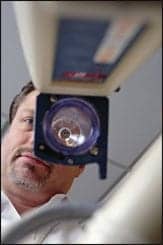 |
| Charlie Santomero, senior radiology technician, calibrates a Medrad injector. |
Alliance with Nursing
“It’s not right for nursing to have to spend hours looking for equipment,” Benesby says. “We now report to the chief nursing officer—or CNO—and that has been a key to our success with nursing. Other biomedical departments typically report to the VP of facilities. The biomedical staff meets once a month with key nursing directors to talk about biomed issues.”
Benesby and Aichroth worked tirelessly to communicate the pump program before they launched it. They met with nursing managers, arranged meetings, and sent countless e-mails. “You have to build rapport with the nurses,” Aichroth stresses. “They are afraid, at first, to let their pumps out of their sight. They are afraid they are never going to get them back. But the four people we have are amazing. Eventually, they were glad to know that biomed was going to try to do something. They were willing to give it a shot. It was a mess before, so the only place we could go was up.”
Biomed Specialist Kirk A. Lis, CBET, attributes the harmony among nurses and biomeds to a culture of kindness, which pervades the entire department. “Our satisfaction scores are the highest of any of the service departments, and I think it is because we treat people nicely,” Lis says. “It’s not rocket science. Communication is also key. We use face-to-face communication, telephone, and e-mail all together. We never belittle or put down a nurse, even if she/he is making a mistake that is obvious—like making sure something is plugged in.”
When nurses call for help, the biomedical engineering department makes the time to respond, a policy that consistently builds up the good will and fosters cooperation. “The nurses will call and say, ‘I know this is probably something you don’t handle, but could you tell me who I could call?’ ” Aichroth says. “But the nurses know that we will go up and help, and they are going to get some sort of answer.”
90% In-House
Benesby believes in the in-house concept, and that philosophy infuses the staff with a can-do attitude. As one example, Lis and Cabrelli have tackled the repair of sterilizers for the past 3 years. “Most of the time, we are able to keep the unit up and running, as opposed to calling the OEM,” Lis says. “It’s a big cost savings, and we do a first look. The reason we don’t usually do that in biomed is that it’s considered kind of a plumbing issue. It is working with steam, pipes, and valves. It is not electronics, and I think that’s why few biomeds even attempt it. We gave it a try, and we’ve been doing it successfully.”
Like many departments, Cooper University Hospital leaves MRI and CT to the OEMs while selectively using ISOs on a time and materials basis. X-ray repair, however, is the province of Charles Santomero, senior biomedical technician. Santomero, a 21-year employee at Cooper, got his x-ray training in the mid 1990s, and he relishes Benesby’s willingness to let biomeds take on additional responsibilities.
Call it empowerment if you must, but staff members are encouraged to trust their instincts and even take on some risks when diagnosing and repairing. “Ben [nickname for Benesby] is willing to take our word when we have a good feeling about what is wrong with a piece of equipment,” Santomero says. “If we think an expensive part is needed, Ben trusts our hunches—knowing that the part may cost thousands, but bringing in a vendor might cost many more thousands. He is willing to allow us to order the part, and usually we can get the part from a third-party source—sometimes brand new, but cheaper than buying from the OEM—or sometimes a refurbished, repaired, or remanufactured part. He will take our word for it and trust our instinct. There have been some failures, but it’s been worth taking those risks because they usually pay off.”
|
Read past department profiles in the 24×7 archives. |
Chucking tradition and taking infusion pumps out of the jurisdiction of central supply has indeed paid off in a big way. Can expansion be far away? “We are asked constantly why we are not doing the same thing with other equipment,” Benesby says. “And I really think it is possible. It should not be difficult to add on to the process, so I am flirting with the possibilities.”
The eight technicians in the biomed department at Cooper have undoubtedly thrived under the system, and Benesby attributes the success to the attitudes and talents of his staff members. “I have great people here in my department, and, of course, that is also key to our success,” he says. “My biomeds are responsive, team oriented, and a good group. They understand that it is about customer service, and that is reflected in our satisfaction numbers.”
Greg Thompson is a contributing writer for 24×7. For more information, contact .


